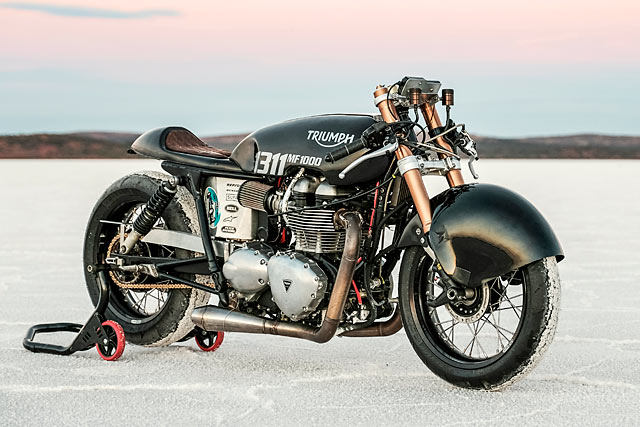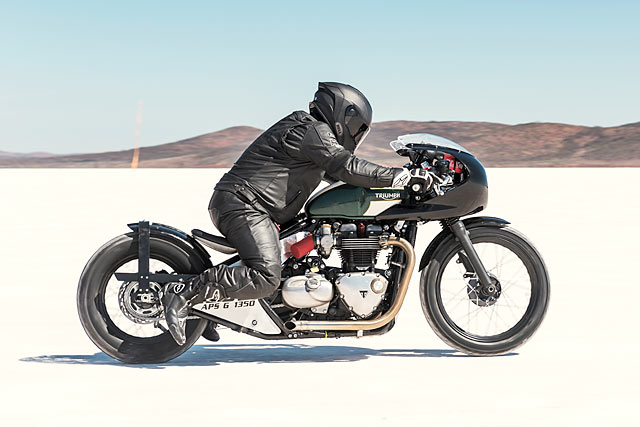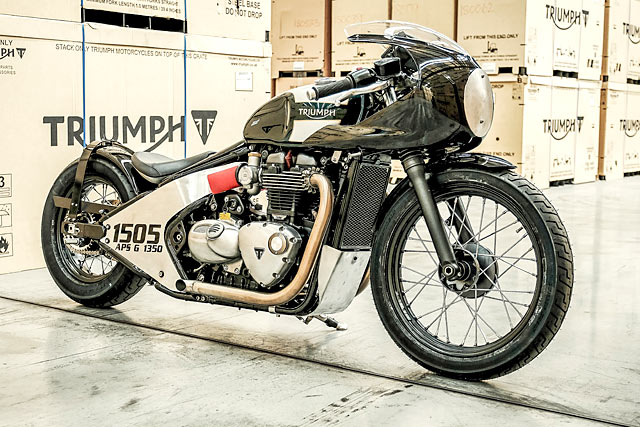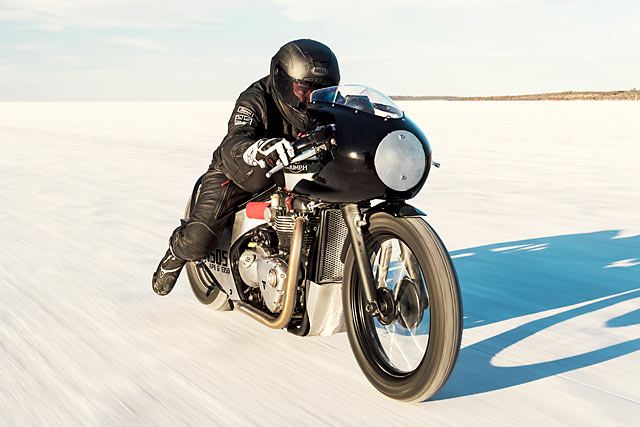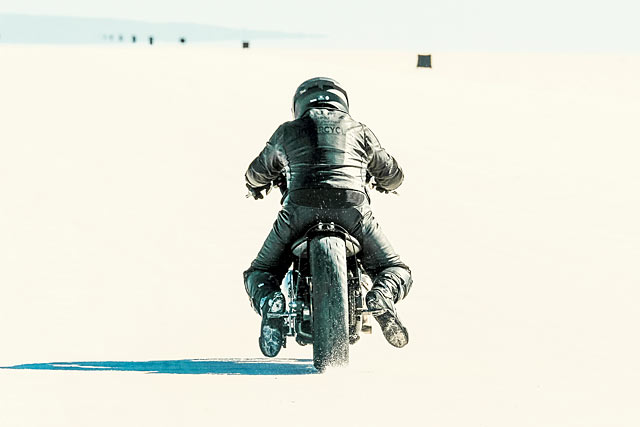Riding your motorcycle flat-out for nine miles across a shimmering carpet of hard packed salt is not everyone’s cup of tea, but if you’re into custom builds and high-speed runs then you can’t look past Lake Gairdner – Australia’s very own version of the famous Bonneville Salt flats. And that’s exactly what three mates with a passion for Triumph’s modern classic range thought a few years back when they heard about the 160 mile long dry lake bed in Central SA that also doubles a massive white drag strip.
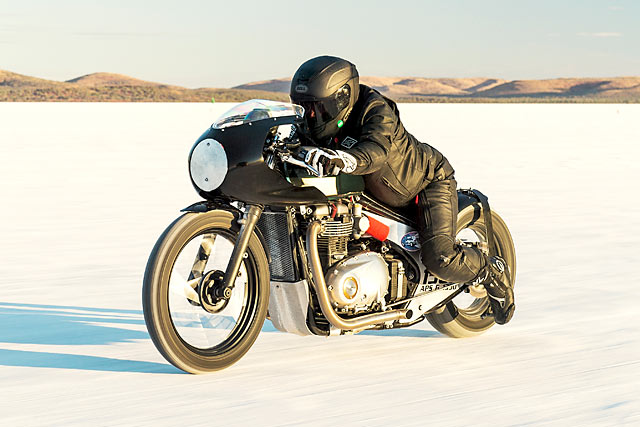
For one week in March each year the vast expanse is transformed into a proving ground for bikes, cars and streamliners during ‘Speedweek’, and this year it also played host to the World Speed Trials for the first time. The FIM sanctioned event attracted engine fettlers and pilots from far and wide with dreams of breaking land speed records on the big white dyno, but some of the most notable achievements ended up coming from our very own backyard.
The Triumph Salt Racer Project, managed by Paul Chiodo of Triumph Australia, ran two machines and enjoyed a week of personal bests that included the unofficial record for fastest naturally aspirated air-cooled parallel twin in the 1000cc unlimited fuel naked class. Their small team, also composed of Triumph Technical Manager Cliff Stovall and Aerospace Engineer Ross Osborne, have been chipping away at the record since 2016. They’re not veterans in the paddock by any stretch, but have learned a thing or two from past experiences and one thing is certain; expect the unexpected on a pilgrimage to the Salt.
Arrests and cracked-out caravan parks are all part of the colourful scenery on this journey into outback Australia. In a way, traversing these badlands is preparation for the extreme conditions on the unforgiving lake bed. The dry salt pan is known for baking temperatures that can exceed 50 degrees Celsius, along with biblical plagues of relentless flies, and the kind of attention to detail that applies to all mechanised racing events these days. Some would say it’s an exercise in patience, but the numbers keep growing and if you’ve ever talked with someone who has built their own bike to meet the challenge of completing a single run at this magical location, they will tell you it was all worth it.
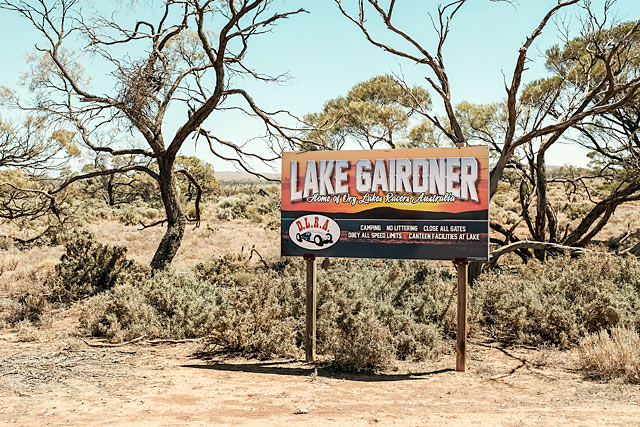
The geography is perfectly engineered by nature to test the limits of any car or motorcycle. Land Speed Records are always in the back of every participant’s mind, but the kinship of doing it tough in one of the most hostile environments known to man with hundreds of your mechanically minded mates is about as close as it gets to ‘nirvana’ for this strange breed of speed demons. It’s an experience like no other and war stories are washed down with the taste of sweet, hoppy malted beverages each evening, to be savoured and stretched, for many Speedweeks to come.
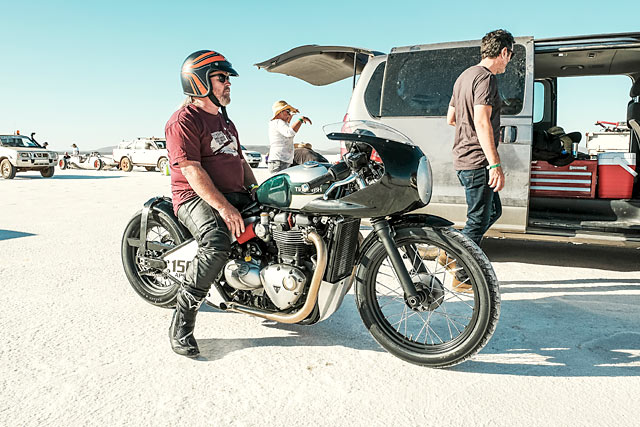
But it’s not all guts and glorious beer. There’s a lengthy process before one can line up at Lake Gairdner, with each crew having to register their machines and riders in advance before a wheel has even turned. The buck stops with the Dry Lakes Racers Australia (DLRA) and once they’ve given their blessing in scrutineering a whole new world opens up for the applicant. You instantly become one of the select few who can ever take a ride on this blindingly white drag strip, and the camaraderie is palpable.
However, just because you have all your ducks lined up doesn’t mean a top speed attempt is a sure thing. First you need to prove that your machine is mechanically sound to hold it on the stop for a long, long time and that you’ve got the bottle to reach its limits without making a mess out there. Only once speed licences are granted can you actually push for a record, and success in this endeavour is tempered by wind corrections as well as the extent of your team’s engineering prowess and the skill of the rider.
[superquote]“Yes, perfect runs on the salt are about as rare as rocking horse shit.”[/superquote]
If you do end up winding through the gears to get up to speed, it’s a little like entering a third dimension where the focus on feel becomes centred on the minute inconsistencies of the salt’s surface and body position are vital to eking those last increments of velocity from your steed. Providing the engine doesn’t expire and everything goes smoothly you’ve got nine miles of marked salt to give it your all. It’s about this point when you’re fully tapped out in top gear that the scorching pan throws up a mottled heat haze at the horizon’s vanishing point that pulls your vision into the translucent blue sky like watching spray coming off a waterfall. Yes, perfect runs on the salt are about as rare as rocking horse shit, but this pastime is as much about the pursuit of mechanical perfection as it is about being one with your machine in a strange alien landscape that few animals dare to invade.
The Triumph Australia Team started their campaign in 2014 with stock Triumph Thruxton airhead and now, after three back to back seasons, their bike has evolved to become a world beater. This year they wrested the title of world’s fastest naturally aspirated air-cooled parallel twin Triumph from esteemed Californian custom builder Matt Capri with a run that was a mere 1 mph faster than the previous year. The humble group of Triumph enthusiasts turned a British modern classic into a fire-breathing twin with three times the original horsepower and looks to match, but also had a hell of a lot of fun in the process. Cliff worked closely with Master Engine Builder Andrew Hallam to unleash the bike’s speed, and Pilot Ross Osborne also lent a hand by fabricating aerodynamic body work and custom carbon fibre components to reduce drag and weight.
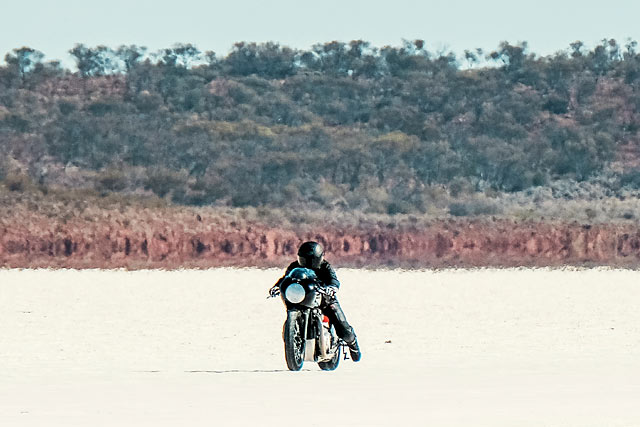
Turning this Hinckley Café Racer into a hotted up salt racer was a project fuelled by passion and delivered by a family whose pedigree in competitive racing has been passed down three generations. “The first two years going out there is quite simply a learning phase. There’s nothing like holding a motorcycle in top gear for 1-2 minutes in 40 degree heat. You can’t replicate that and you learn your lessons hard out there on the big white dyno”, explained Paul of the group’s first two attempts. “This time around we had very strong preparation, a much wiser team. We had Andrew Hallam on site with all his wisdom and experience, and the results speak for themselves. There were no issues, no engine failures… and we raised the Thruxton’s top speed from 156.2 mph to 157.2 mph which makes it the fastest one in the class. The Bobber did 146 mph in its inaugural year but there’s plenty left for next year.”
When asked about plans for 2019, Chiodo keeps his cards close to his chest. “We definitely want to go back and there will be further development on both bikes but exactly what form that takes in terms of class and engineering has yet to be decided. When we started the Thruxton project we wanted to build the most beautiful bike that went fast, but quickly moved on to create an extremely fast bike that looks magnificent.”
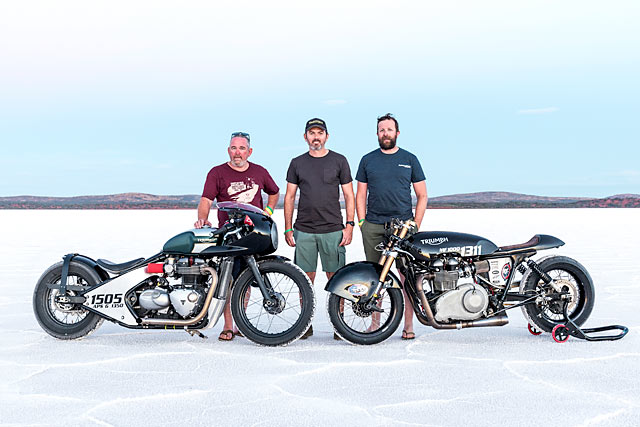
Tech Specs:
2010 Triumph Thruxton. Class: MF 1000 = Modified Fuel (MF) up to 1000cc naked. Modifications: 6mm Stroker with a 92mm Bore = 998cc, head work, high lift and big duration cams, 3mm oversized valves, 58mm throttle bodies off a Harley Davidson V Rod, Rooo16 Race Fuel, stretched swingarm, custom-made bodywork, custom handmade exhaust, aftermarket tuning system with data loggers.
2016 Triumph Bobber. Class: (APS G 1350) = Special Construction (A) Partial Slip streamer (PS) Pump Gas (G) up to 1350cc. Modifications: cylinder head worked 3mm oversized valves, high lift and big duration cam, stretched swingarm, changes seating position, combination of Thruxton and custom bodywork, custom handmade exhaust, aftermarket tuning system with data loggers.
[ Triumph Australia – Facebook – Instagram | Photos by Ross Osborne & Simon Davidson ]

